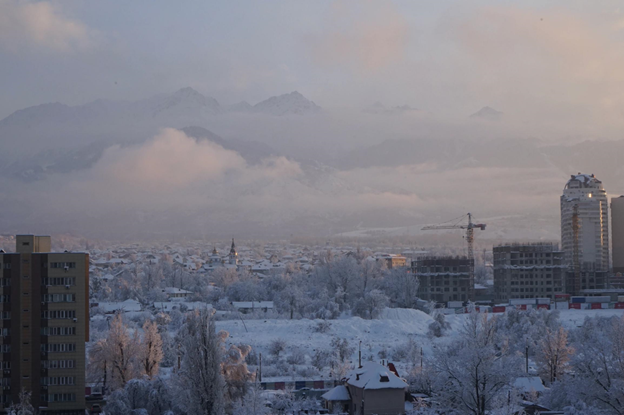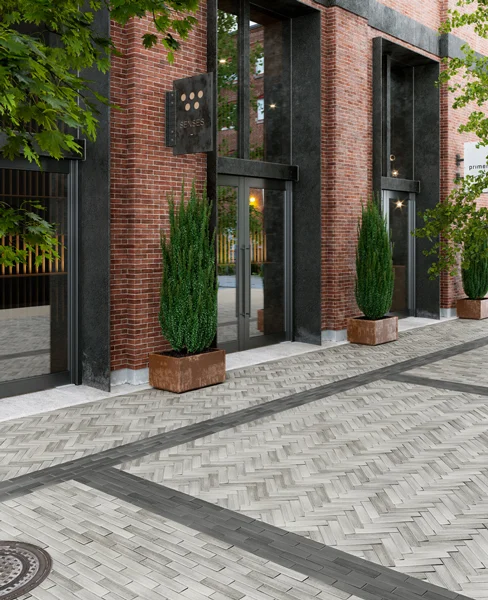Designing a beautiful commercial space means creating an environment that will attract and inspire visitors no matter how many times they’ve seen it. But in northern climates, freezing temperatures and icy conditions can make architects and building owners feel limited in their design choices, forcing the focus to be primarily on function instead of form.
But it doesn’t have to stay that way. Seasoned commercial professionals have learned how to balance the performance required for below-freezing climates with the stunning form that makes our towns and cities special and unique.
Commercial Buildings: Winter Survival Guide + Tips

From exterior cladding to seasonal landscaping and maintenance, architects have to consider the reliability of the materials they design with, and building owners will need to understand what kind of upkeep is required during the life of the building.
Commercial architects have the opportunity to create a strategy for protection and long-term durability when they’re working in northern climates and it helps when you start thinking about it from the top down.
Getting Your Roof Ready for Winter
Building codes help architects design commercial roofs the right way. Cold climates can wreak havoc on your roof design, so the focus should be on damage prevention and building protection. The roof assembly will need to meet your local standards and building code requirements for commercial building roof systems, drainage systems and decking. You’ll want to ensure that the entire roof system tests against any snow and wind load requirements.
But after construction is complete, proper year-round maintenance is a must: It will also help to ensure the roof protects your building as it should. “The summer heat can cause cracks in the membrane while heavy winds can cause wind uplift. Often this damage goes undetected until winter when the roof may sustain even further damage from heavy snow loads or ice expansion,” says Dave Bendel for Roofing Contractor.
The best way to prevent further damage is to address maintenance well ahead of time. “To reduce the risk of leaks — or worse, a whole roof section collapsing — it’s imperative to identify and eliminate all defects and problems of a building’s roof before winter begins,” writes Bendel.
That means clearing the area of any debris, but also inspecting the roof early on for possible damage, leaks or other problems, before temperatures start to drop.
Selecting Windows for Cold Weather
The windows on a building understandably have a huge impact on how your space performs when it comes to energy efficiency — but windows can also make a big statement when it comes to your building’s style.

Windows connect indoor occupants with the outdoors and making the outside more accessible to people inside of a building has been shown to improve their emotional and physical health.
But architects will need to balance their daylighting strategy with an energy-efficient building design. “Typically, the overall goal is to achieve the best possible daylight transmission at cost of the least heat transmission,” according to Whole Building Design Guide.
It all comes down to finding high-performance windows with the right glazing. “Radiative heat can be transferred through long-wave infrared radiation and through solar radiation. Either kind of radiation can be minimized by low-E coatings on the glass, which are one of the most effective means of improving window thermal performance,” according to WBDG.
Building owners will also want to ensure that their windows aren’t allowing any air leaks, and should take time (at least once a year) to inspect windows for any damage, cracks or gaps. This will go a long way towards optimizing the building’s insulation and prevents costly energy bills.

Considering Your Commercial Exterior Cladding
When it comes to commercial cladding, architects have a wide array of options to choose from. The goal is to protect the interior of the building and to help with insulating the space properly.
Building owners will also want a material that isn’t high maintenance: Constant upkeep just isn’t in the cards if you want your commercial clients to be happy with the exterior design. There are a few types of exterior cladding that will stay stylish and strong for the long term.
Stone and brick are considered some of the strongest materials in the industry, and they require little upkeep. These types of exteriors can be more expensive, however, and require a subcontractor for installation.
But choosing fiber cement cladding might be a better option. It gives building owners a more affordable exterior and isn’t just for residential projects. Many modern commercial exteriors feature fiber cement because it’s an affordable and easy-to-install option that doesn’t require a mason for the project. Fiber cement can stand up to rain, snow, heat and wind, and it won’t need a new paint job every year (like a wood exterior might). Bonus points that it can be installed anytime of year — even if it’s snowing!

Winter Landscape Maintenance
To ensure your commercial exterior’s style stays beautiful, you’ll want to check in on the plants and landscaping materials you design with: This also goes for any green roofs or deck gardens on your exterior.
- Design your commercial exterior with native plants and trees that aren’t going to die off when temperatures start to drop. Trim back plants to encourage new growth when temperatures rise again.
- Make sure the building’s maintenance plan includes inspecting plants and landscaping regularly: Look out for any pest infestations and dead foliage, and be sure to clear away fallen branches in the area.
- Rain and snow can make a pond out of neglected landscaping and exterior grounds, so make sure there is sufficient drainage and the right waterproofing strategy to protect the ground around the building.
- “Protection, drainage and isolation along with thermal considerations must be incorporated into the design,” according to the Whole Building Design Guide. Choosing the right pavers will make a big impact on your building’s landscaping architecture and can protect the building’s foundation.
- You should also ensure the landscaping pavers are tested for harsh conditions like freeze/thaw cycles and any salt or deicing agents. They’ll need a protective coating and should feature permeability or heating options for building visitors’ safety.
Pavers from manufacturers like Techo-Bloc have a commercial warranty that covers deterioration caused by deicing salt. The warranty covers the structural integrity of the pavers and any abnormal deterioration caused by rock salt, which is typically used for de-icing pavers, slabs or steps.

Designing Better Commercial Building Exteriors
Maintaining your commercial building’s design shouldn’t be on the back burner, and with consistent upkeep, building owners can ensure their space and its exterior stays stylish, even in the coldest winter weather.
From your building’s roof system to the landscaping pavers, working with reliable materials can help to guarantee the success of your commercial design. And choosing products like Techo-Bloc, which come with an industry-leading commercial warranty, gives you peace of mind that you have both the aesthetic to wow visitors and the performance to last a lifetime.
Learn more about Techo-Bloc’s solutions for commercial buildings. Take a look at the details behind our product warranty, or explore our offerings on our website.

Leave A Comment